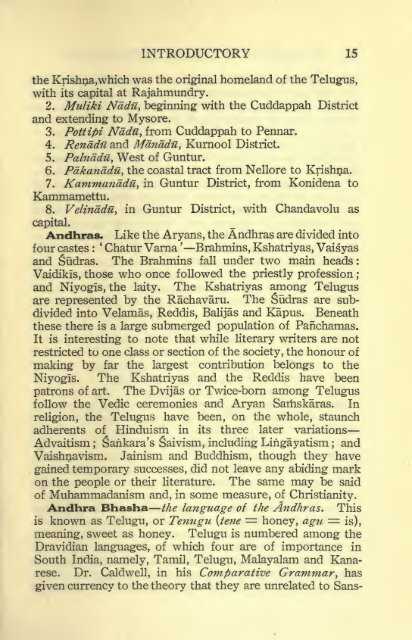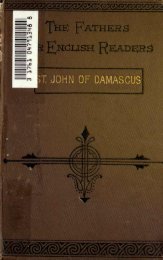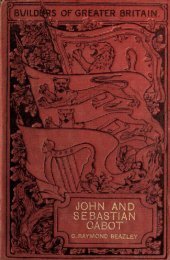A history of Telugu literature; - Cristo Raul
A history of Telugu literature; - Cristo Raul
A history of Telugu literature; - Cristo Raul
Create successful ePaper yourself
Turn your PDF publications into a flip-book with our unique Google optimized e-Paper software.
INTRODUCTORY 15<br />
the Krishna,which was the original homeland <strong>of</strong> the <strong>Telugu</strong>s,<br />
with its capital at Rajahmundry.<br />
2. Muliki Nadu, beginning with the Cuddappah District<br />
and extending to Mysore.<br />
3. Pottipi Nadu, from Cuddappah to Pennar.<br />
4. Renadu and Manadu, Kurnool District.<br />
5. Palnadu, West <strong>of</strong> Guntur.<br />
6. Pdkanadu, the coastal tract from Nellore to Krishna.<br />
7. Kammanadu, in Guntur District, from Konidena to<br />
Kammamettu.<br />
8. Velinadu, in Guntur District, with Chandavolu as<br />
capital.<br />
Andhras. Like the Aryans, the Andhras are divided into<br />
'<br />
Chatur Varna '<br />
Brahmins, Kshatriyas, Vaisyas<br />
four castes :<br />
and Sudras. The Brahmins fall under two main heads:<br />
Vaidikis, those who once followed the priestly pr<strong>of</strong>ession ;<br />
and Niyogis, the laity. The Kshatriyas among <strong>Telugu</strong>s<br />
are represented by the Rachavaru. The Sudras are subdivided<br />
into Velamas, Reddis, Balijas and Kapus. Beneath<br />
these there is a large submerged population <strong>of</strong> Panchamas.<br />
It is interesting to note that while literary writers are not<br />
restricted to one class or section <strong>of</strong> the society, the honour <strong>of</strong><br />
making by far the largest contribution belongs to the<br />
Niyogis. The Kshatriyas and the Reddis have been<br />
patrons <strong>of</strong> art. The Dvijas or Twice-born among <strong>Telugu</strong>s<br />
follow the Vedic ceremonies and Aryan Samskaras. In<br />
religion, the <strong>Telugu</strong>s have been, on the whole, staunch<br />
adherents <strong>of</strong> Hinduism in its three later variations<br />
Advaitism ; Sankara's Saivism, including Lingayatism ; and<br />
Vaishnavism. Jainism and Buddhism, though they have<br />
gained temporary successes, did not leave any abiding mark<br />
on the people or their <strong>literature</strong>. The same may be said<br />
<strong>of</strong> Muhammadanism and, in some measure, <strong>of</strong> Christianity.<br />
Andtira Bhasha the language <strong>of</strong> the Andhras. This<br />
is known as <strong>Telugu</strong>, or Tenugu (tene = honey, agu = is),<br />
meaning, sweet as honey. <strong>Telugu</strong> is numbered among the<br />
Dravidian languages, <strong>of</strong> which four are <strong>of</strong> importance in<br />
South India, namely, Tamil, <strong>Telugu</strong>, Malayalam and Kanarese.<br />
Dr. Caldwell, in his Comparative Grammar, has<br />
given currency to the theory that they are unrelated to Sans-

















